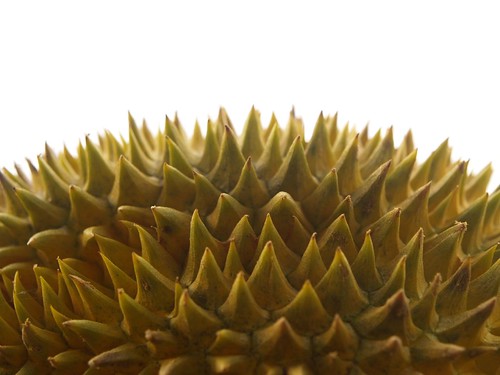http://en.wikipedia.org/wiki/Durian
From Wikipedia:
Writing in 1856, the British naturalist Alfred Russel Wallace provides a much-quoted description of the flavour of the durian:
"A rich custard highly flavoured with almonds gives the best general idea of it, but there are occasional wafts of flavour that call to mind cream-cheese, onion-sauce, sherry-wine, and other incongruous dishes. Then there is a rich glutinous smoothness in the pulp which nothing else possesses, but which adds to its delicacy."
Wallace cautions that "the smell of the ripe fruit is certainly at first disagreeable"; more recent descriptions by westerners can be more graphic. The English novelist Anthony Burgess famously said that dining on durian is like eating vanilla custard in a latrine.
Travel and food writer Richard Sterling says:
"... its odor is best described as pig-shit, turpentine and onions, garnished with a gym sock. It can be smelled from yards away. Despite its great local popularity, the raw fruit is forbidden from some establishments such as hotels, subways and airports, including public transportation in Southeast Asia."
The unusual odour has prompted many people to search for an accurate description. Comparisons have been made with the civet, sewage, stale vomit, skunk spray, and used surgical swabs. The wide range of descriptions for the odour of durian may have a great deal to do with the wide variability of durian odour itself. Durians from different species or clones can have significantly different aromas, and the degree of ripeness has a great effect as well. In fact, three scientific analyses of the composition of durian aroma — from 1972, 1980, and 1995 — each found a different mix of volatile compounds, including many different organosulfur compounds, with no agreement on which may be primarily responsible for the distinctive odour.
This strong odour can be detected half a mile away by animals, thus luring them. In addition, the fruit is extremely appetising to a variety of animals, from squirrels to mouse deer, pigs, orangutan, elephants, and even carnivorous tigers. While some of these animals eat the fruit and dispose of the seed under the parent plant, others swallow the seed with the fruit and then transport it some distance before excreting it, the seed being dispersed as the result. The thorny armored covering of the fruit may have evolved because it discourages smaller animals, since larger animals are more likely to transport the seeds far from the parent tree.




